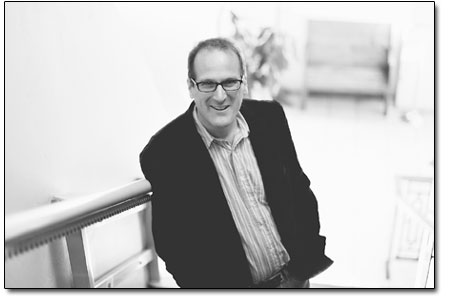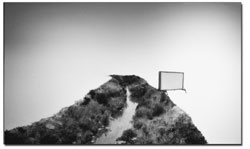|
| ||||
| Visual communication
by Jules Masterjohn Upon first encounter with Kevin Bell’s Land-Object painting series, one might perceive segments of land floating in midair. In the paintings, parcels of terra firma, rendered in convincing perspective, tentatively hover in stark whiteness. Perhaps this is due to Bell’s previous career as a sea kayak guide, where he spent his days riding ocean swells off the coast of Alaska. This ungrounded quality is especially obvious in his oil painting “Cars.” In it, a junkyard – with its clutter and tonnage of metal stacked in rows – turns into an undulating and wispy fabric for our consideration. Bell’s latest exhibition, “Disturbed Land,” on display at the Durango Arts Center Art Library, offers us eight such paintings to ponder. And ponder we should, for embedded in the paintings are his observations on our culture’s habitation of the land. Bell takes his role as visual communicator seriously, and his works are actively showing throughout Europe and the United States. Last year, he exhibited in San Francisco, Chicago, New York, and Hamburg, Germany. This year, he has been invited to participate in a group show in Berlin. In addition to his busy exhibition schedule, Bell is a full-time art professor at Fort Lewis College. He also is the editor of a scholarly journal published by Foundations in Art: Theory and Education (FATE), an organization dedicated to excellence in the teaching of college-level art courses. Bell is an able communicator with both images and language, articulate and conversant on topics of contemporary culture. We spoke about his art and his role as a visual communicator. Jules Masterjohn: I am struck by a sense of absence in your Land-Object paintings. Your subject matter seems to imply human activity yet people are nowhere to be found. What is your implication with this absence? Kevin Bell: I think it is there for a couple of reasons: often it is only possible to see the underlying structure or nature of things when there is not the distraction of people. I notice things in the land that I miss when negotiating a conversation, or interacting with friends and strangers. When alone, it is often easier to look closely. Secondly, although I greatly enjoy painting figuratively, whenever people are present in my images, the painting becomes about them. The figurative narrative is so strong that the landscape always becomes merely a backdrop for their particular drama. I want to focus as much as possible on the land. JM: The painted-out areas in the Land-Object series can be read a number of ways. Leaving the canvas unpainted has a powerful implication. KB: For me, the blank areas force the landscape to read more like objects rather than complete vistas. I think this is how we see and remember particular places: often it is something that catches our eye rather than the whole view. Perhaps this is because the view is so crowded with contradictory information that we subconsciously select certain elements and filter out unwanted elements. Or perhaps this is because of the fragmentary nature of our culture. We drive fast through the land, flip channels and surf the web collecting pieces of information without a complete narrative. In any case, both imply a certain distancing between us and the land. My memory of a place does not include everything but rather just a fragment. It therefore seemed less honest to paint everything if I was only paying attention to a small part.
Lately, what has been catching my eye is where nature exists or is evident. Not big iconic mountains, but more mundane and overlooked things like parking islands left to go wild or a plot of grass set aside or the curve of a hill articulated by rows of junk cars. Such elements are oddly dependent on manmade markers for context and location. JM: Your chosen palette in the paintings from the Domestic Disturbances series is low-key, which adds to the monotony that your subject matter, suburbia, can connote. Talk about color and its psychological implications. KB: Yes, the Domestic Disturbances are not bright. But as you noted, this is to add to the air of suburban calmness and predictability. I also wanted to give space for the small things going amiss (the fallen tree, transformer fire, breached wall) to remain small but still feel somewhat jarring without being overwhelmed by the rest of the painting. Big colors would have made these paintings feel too dramatic or full of anguish. The dull colors for me imply an average day, with a small twist that somehow alters perceptions ever so slightly. I use a fairly limited palette (four or so colors plus white) to achieve this effect. JM: I had a conversation with an artist about your Land-Object paintings, and this person’s take on the work was that it seemed unfinished. Does it matter to you that your paintings may be understood differently by different viewers? KB: On one hand, painting is my main form of communication, and I greatly wish others to take away from the work what I intended. It is always exciting when your own take on the world is understood by others. But that said, there is an intuitive aspect to creating, and the meaning of a piece is not always fully visible to the artist. Sometimes an outsider can shine a little light on all those solitary hours in the studio. • The exhibit, “Disturbed Land,” is on display through Feb. at the Art Library, upstairs in the Durango Arts Center, 802 E. Second Ave. Viewing hours are Mon.-Sat., 10 a.m.-5 p.m., though hours may vary. Call 259-2606 for more info.
|
In this week's issue...
- September 11, 2025
- Back on top
After harrowing flying accident, local highliner steps back out with renewed mission
- September 11, 2025
- New order
Rule change for Land and Water Conservation Fund raises alarms
- September 4, 2025
- Armed with knowledge
Local community organizers work to ensure immigrant neighbors know their rights



